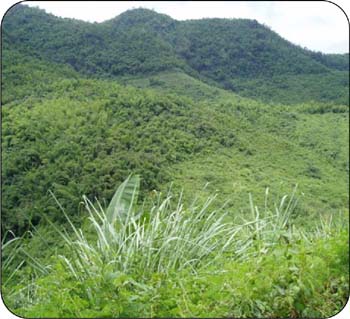Clearing forests for food production, excessive and wasteful logging practices, and inappropriate use of fire - - these are some of the main drivers behind the extensive deforestation in the Asia-Pacific region over the last two decades.
As a result, a dramatic change in the amount and nature of vegetation across the region has emerged.
While cropland areas have increased, a smaller but significant increase in abandoned lands has also occurred in cases where agriculture had been unsustainable, or where lands had been degraded by other causes such as mining (Gilmour et al. 2000, FAO 2001).
The very large areas across the region now occupied by Imperata cylindrica are only the most obvious sign of this increase in degradation. Menz et al. (1998) estimates these areas now cover 35 million ha in Asia alone.

Imperata cylindrica... this is the most obvious sign of degradation.
In addition, many of the remaining forests have been badly damaged by intensive and inappropriate logging practices. These forests will need to be protected for many decades before they can be re-harvested.
Some of this residual forest is best described as "regrowth" or secondary forest. Such forests are often found at the most heavily logged sites and at some former agricultural lands that have since been abandoned. Few of these secondary forests will be able to supply timber resources in the near future (Hurst 1990, Gilmour et al. 2000, Dauvergne 2001).
Many of these changes in forest cover have supposedly taken place to improve the wellbeing of rural communities. It is disappointing to note, therefore, that there are still large numbers of poor people living in rural areas throughout the region, with many still not yet benefiting from the forest clearing or exploitation that has been carried out in recent years.
Instead, it is widely recognized that these changes in forest cover have caused serious problems for many people. These woes have included a loss of "goods" traditionally obtained from forests (including not just timber, but also non-timber forest products such as medicinal plants and foods that many rural and forest-dwelling people have used).

Forests recovering after heavy logging... these are known as secondary or regrowth forests. Although regarded as highly degraded and therefore worthless, they often contain many resources useful to rural communities and significant levels of biodiversity. More information is needed on appropriate ways to silviculturally manage these forests.
The changes have also led to a loss of ecological services (such as watershed protection and biodiversity) that the wider community has valued and previously taken for granted.
In part, to combat forest losses, some reforestation has occurred, and in some cases, the areas involved have been large. However, in most areas, reforestation has not kept pace with the increases in the areas of abandoned and degraded lands (even accepting that "degraded" land is difficult to define and map with precision).